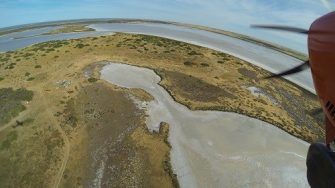
Date: Friday, November 7, 2014
Project: Eastern Australian Waterbird Survey
Observer: Richard Kingsford
The weather forecast was against us – 30 knot winds and 38 degrees centigrade. So we were up at daybreak, hoping to get in early before the wind bumped us all over the place. It was smooth for the first 15 minutes before the northwesterly wind funnelled through dunes of the Coorong and buffeted us around.
Photo 1. Sunrise over the Coorong as we surveyed south past the Murray Mouth and then the north and south Coorong – an amazing distance of about 130 km.
The Coorong is open to the sea and stretches south from the town of Goolwa, with the barrages (see yesterday) separating the sea from the freshwater lakes. Just past the town of Goolwa, we passed our first barrage before we started heading south.
Mouth of the Murray and the Coorong, only a short walk from the sea. The salt waters are separated from the fresh waters by a barrier (barrages).
Hundreds of grey teal and chestnut teal, red-necked avocets, and Australian shelduck hugged the eastern edge of the Coorong and took flight when the plane passed. Just what we needed. It was only when in flight we could be sure of our identifications.
Photo 2. The Coorong and the mouth of the Murray are a very complex large wetland system which provides habitat for tens of thousands of waterbirds.
But there were plenty of other waterbirds in their hundreds and sometimes thousands. And there were also thousands of migratory shorebirds – tiny birds which had made their way from their nesting ground in China and Russia to the Coorong. They come for the rich food on offer but over the years their numbers have been declining as the system has become more saline without the freshwater flows from upstream. This is a Ramsar site, wetland of international importance, that the Australian Government has admitted has likely changed as a result of human impacts. Still, this system is special – no doubt. An incredible diversity and astounding numbers. Our pilot Richard jokes that our tape recorders must have smoke coming out of them today.
We do two counts of this system which takes us nearly three hours in a small plane. The Coorong gets progressively saline as we head south. In fact, over the eight years I have been surveying this wetland, I haven’t seen it as contracted as it was today.
Photo 3. The north Coorong is notionally separated from the south by a narrow channel but there were also lots of salt bays in this part of the system which might be normally under water.
The other surprise – where were the banded stilts? These remarkable birds fly in extremely tight formations and head off for the inland when the rains come. We have just surveyed a third of the inland and didn’t find them. So they must be somewhere else. There were less than a hundred today. When they are here – there can be tens of thousands. Even the pelicans which breed each year only numbered a handful compared to the thousands we have counted in the past.
Photo 4. A small group of Australian pelicans nesting on one of the islands in the south Coorong.
Waterbird surveys are all about following the edges. You need to find the edge of the wetland because this is the shallow bit where the waterbirds hang out. So we just fly inside the edge so one person can count the ‘edge’ and the other the ‘middle’.
Surveying waterbirds around the mouth of the Murray River
We rested after our bumpy ride before tackling the second count on the two freshwater lakes: Lake Alexandrina and Lake Albert. We knew what to expect as we had surveyed them the previous day. Our aim is to survey each wetland twice to get some measure of the variation in our counts.
Photo 5. A photo of our GPS on the dash of the plane showing our flight path around the Lower Lake (Lakes Alexandrina and Albert), the Murray Mouth and just the beginning of the Coorong.
The lakes predominantly get their water from the River Murray but also local rainfall down creek systems is an important part of the ecology. There are northwestern ‘arms’ of the lake which go up to meet the creek systems and have large reedbeds.
Photo 6. Local creeks come down to contribute water to the lakes which penetrate up to join these creeks.
The freshwater lakes had huge numbers of fish eating birds, particularly pelicans and the four cormorant species (great, pied, little pied and little black cormorants). The two larger species (great and pied) were everywhere in their thousands.
Great cormorants, pied cormorants and pelicans roosted on islands in Lake Albert in their collective flocks of thousands.
Tomorrow, we head back north to do our second count along the River Murray from Berri to Wentworth.
